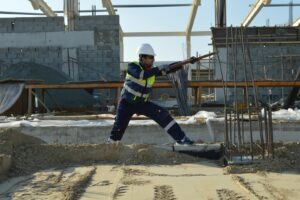As cuts start to bite and public services and regeneration funds are withdrawn, housing associations are picking up the extra demand. But can they, and should they, fill the gap in regeneration provision? Clare Goff and Austin Macauley investigate
 When the Accord Group of housing associations wanted to ensure local supplies of the timber frames it uses to build new housing in Redditch, it decided to open its own factory. Based in Beechdale, the factory employs 30 staff and will supply timber frames for 250 homes in its first year of business.
When the Accord Group of housing associations wanted to ensure local supplies of the timber frames it uses to build new housing in Redditch, it decided to open its own factory. Based in Beechdale, the factory employs 30 staff and will supply timber frames for 250 homes in its first year of business.
Moving into manufacturing may be an unusual move for a housing provider but it’s just one of the new avenues being taken up by housing associations as they expand their remit in local economic development.
As Chris Handy, chief executive of the Accord Group, says, the factory allows the group to reduce its carbon footprint as well as supply much-needed local jobs. Accord has launched a number of non-core housing activities in recent years, including a social networking site for young people, and has taken over the running of a community centre and a meals-on-wheels service from its local authority.
‘We work in these communities and are part of the social and economic fabric. We’re not separate from them,’ he says.

Kerry Bolister of Sandwell Council, Accord Group chief executive Chris Handy, Anne-Marie Simpson, head of Midlands Central for the Homes and Communities Agency and Akshay Parikh, chair of the Accord Group pictured at the Eastern Gateway development in West Bromwich.
Running non-landlord services is not a new departure for the UK’s housing associations. As non-profit organisations working in the most deprived areas in the UK, the overall health and wellbeing of their tenants and the communities in which they operate is their raison d’etre. It also makes good business sense, thriving tenants and neighbourhoods leading to a healthier asset base.
As the public sector withdraws, housing associations are increasingly relied upon to expand their range of broader regeneration activities. While the voluntary and public sectors have faced cuts and redundancies, registered social landlords (RSLs) have been relatively protected and have stepped in to respond to the dramatic changes in local neighbourhoods.
An ongoing Rapid Research survey undertaken by New Start has found that housing associations are increasing their regeneration activities. All providers taking part in the survey said that they consider local economic development part of their remit, with 80% planning to increase non-landlord activities in the coming year, particularly in employment support and training, welfare support and health and wellbeing.

Clayton Brook playground in Preston, one of the projects that has comes about through the £15.6m Green Spaces for People programme run by Places for People.
Trent and Dove, a housing association based in east Staffordshire, has expanded its activities in response to increased local demand. ‘Our starting point is to respond to local circumstances. Anything that needs to be done, we’ll do, including economic development and regeneration,’ says chief executive Ron Dougan. Its activities now include a family intervention project and a credit union scheme and in recent years it has undertaken a £7m scheme to rebuild a public estate in Uttoxeter, all without additional financial support.
Places for People has reorganised its business around neighbourhood planning in the last three years and has woven economic development into its broader strategy. ‘It’s hard to draw the line between core housing function and what isn’t,’ says director of neighbourhoods Steve Mather. The organisation has helped local people set up 42 new businesses and two social enterprises. Mather says that if they didn’t deal with the issues now those problems would still be there 20 years down the line.
Brendan Sarsfield, chief executive of Family Mosaic, says that his organisation is increasingly called on to help people back into work and replace the shortfall in youth services. ‘These services are underfunded and we get the backlash in so many ways. We do lots of things that the state was doing before.’
As the default operators within communities, regeneration work that would previously have been undertaken by local government is now being placed at their door, including public services.
‘We will always be there and in some areas we are the last man standing,’ says Stephen Porter, chief executive of Great Places Housing Group. ‘The libraries, community centres and youth opportunities have all been closed down. We will always be there and are left holding the baby.’
THE LIMITS TO RESPONSIBILITY
But should – and could – housing associations fill the void left by the withdrawal of funds and services from the public sector? Abigail Davies, director of policy and practice at the Chartered Institute of Housing, says there are limits to how much extra responsibility housing organisations can take on.
‘No provider wants to see their area fall apart but the shifting of responsibility and costs needs to be done more carefully. Housing officers already feel like social workers, employment advisers and policemen.’
While RSLs feel it is part of their remit to fill the gap left by the withdrawal of public funds, few have the financial resources to do so indefinitely. Housing associations have not faced the widespread redundancies and cuts of the public and voluntary sectors, and are insulated by their housing assets and rental income, but they are far from immune to cuts, policy changes and economic insecurity.
The 60% cut to the affordable housing capital budget announced in the comprehensive spending review has hit housing providers hard, and brought affordable housebuilding to a standstill; new figures from the Homes and Communities Agency reveal a 97% drop in new homes built in the last six months compared to last year.
Housing providers are also dealing with greater uncertainty in the money markets, and cuts and changes to rents and constraints on the benefits system, all of which make their incomes less secure.
As Mr Porter says: ‘The world feels a lot riskier now than two or three years ago. Banks are re-pricing loans and that totally wipes out our surplus. They are causing anxiety and housing associations are taking cover.’
Many are undergoing reorganisation and finding new ways to deal with cuts. Ron Dougan says that rather than make people redundant, he is stretching value for money, taking a lean systems approach, driving waste out of the system and negotiating hard.
But, he says, ‘there is a limit’ to what housing associations can do and he does not want to see rents increase to allow housing associations to provide what should be core public services.
Family Mosaic is already feeling squeezed by the extra demands on its resources. It is midway through a survey of tenants and other stakeholders in an attempt to narrow down the organisation’s priorities. It is asking respondents to rank what the provider sees as its four key responsibilities – as a landlord, a community developer, a builder of new homes, and helping people to move on – in order of importance. It’s proving to be a close run race, with ‘helping people to move on’ currently proving least popular.
Chief executive Brendan Sarsfield says that before the organisation considers expanding its remit in regeneration it needs to decide its core purpose and hopes that this research will help narrow down its focus. He would like to see the same prioritised approach taken across the sector, with, perhaps, each housing association group concentrating on a different issue. ‘We need to focus. We are getting too thinly spread.’
For Paul High, managing director of Orbit Homes, the issue isn’t about whether or not housing organisations should perform a broader role but more the need to recognise the financial realities that they must work within.
‘We have a specific community investment budget each year. It’s about direct investment in things as simple as paying for a money advice worker, play facilities on an estate where there are none at the moment. Or it may be contributing to the cost of building community facilities, training projects.’
He adds: ‘So, do we see it as part of our job? Yes, that’s the benefit of having a social business. What we’d stress and are becoming increasingly aware of is in order to do that you have got to make that money somewhere.’
GETTING THE RIGHT BALANCE
So what should the priorities of housing associations be? A recent publication by think tank Respublica set out the difficult choices for housing associations as they weigh up reduced grant funding with greater community need. Changes in government funding are forcing housing associations to choose between development and wider community activities, and striking a balance between the two will be fundamental to their future. At the Crossroads pinpointed five key areas in which housing associations can play a greater role in the fabric of their communities: as enablers, investors, active funders, broader service providers and supporters of local cooperation and self-help.
Jas Bains, chief executive of the Ashram Housing Association, also makes the case for a more balanced investment approach and contemplates housing associations of the future playing a role in the development of the local civic economy and run, not as now, by those with development and financial skills, but by those with skills in community development and social innovation.
Housing associations are already responding to the political and economic changes of recent years and taking up the challenge of localism and the Big Society. They are moving, not only into new areas of work, but also into new partnerships at the local level. Wirral Partnership Homes and NHS Wirral have joined forces to put together a plan to redevelop a recently demolished neighbourhood in West Kirkby, including 58 new homes and a health centre.
Many are working more closely with the private sector. Accord Group, for example, has worked with Marcity on three projects and hopes to increase such partnerships. Link-ups with the voluntary sector are also increasing and the results of Together for Communities, a pilot project launched by housing charity Hact, shows the mutual benefits gained when housing providers link up with voluntary and community sector groups in their localities.
Twelve partnerships were identified to take part in the pilot, including a partnership between the Ferry Project and the Luminus Group, based in East Anglia. The Ferry Project provides accommodation for homeless people and launched a hostel and community hub in 2008. As a result of its partnership with the Luminus Group, the two organisations have now merged, giving stability to the Ferry Project and providing Luminus with a specialist service it previously lacked.
Overall the pilot has shown the mutual benefits of stronger ties between community anchor organisations and housing providers, with housing associations offering strategic support to their local community sector in return for its expertise in community development.
But there are major barriers, aside from funding, that prevent housing associations from expanding their local regeneration activities and partnerships. Many of those who took part in our Rapid Research cited a lack of ambition and innovation by the public sector; for, despite the introduction of build now, pay later schemes, the public sector remains cautious. The silo-based nature of commissioning is seen as a mismatch to the more holistic approach of the RSL sector. Some found themselves ‘talking a different language’ to the voluntary sector.
As Wales demonstrates, a housing association sector that is supported in its role in regeneration will continue to expand its brief. England, with a lacklustre regeneration strategy and deep cuts to housing, has so far done little to support the work of housing associations, despite the sector being one of the best examples of Big Society in action.
Housing associations are keen to play a lead role in developing a new local economic development, based on strong local partnerships with the public, private and voluntary sectors. With support and small amounts of additional funding, they could help transform deprived communities.
But whether they stand up and play a lead role or take cover as economic insecurity increases, will be largely down to how their position of ‘the last man standing’ is recognised and sustained.
- Read the ezine version of this article – includes focus on Wales and analysis from Jas Bains of Ashram Housing Association.
- New Start will be examining the role of Scotland’s housing associations following the publication of the Scottish Government’s regeneration strategy.


















Leave a Reply